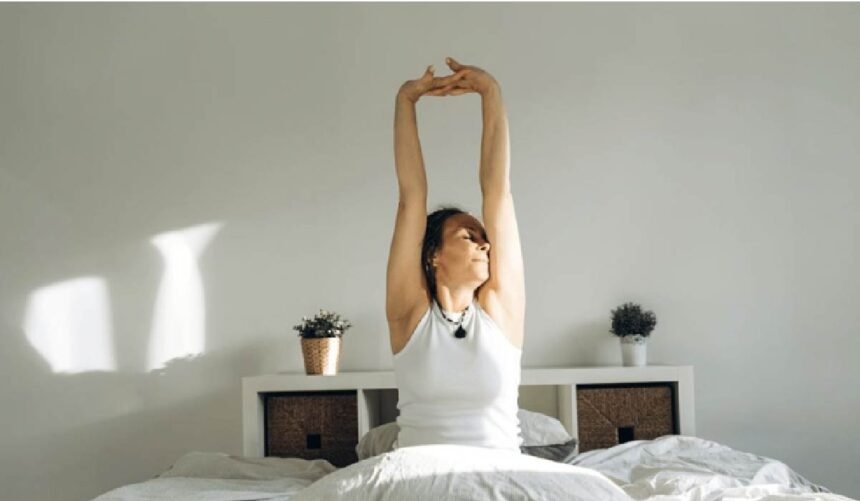I’d been convinced for years that my sleepless nights were just part of who I am. Some evenings I would fall asleep as soon as my head hit the pillow; other nights I’d lie there with the ceiling staring down at me, cataloguing losses from the day, rewinding awkward conversations, making plans that sounded better at 3 a.m. than they did in daylight. The clock on my nightstand ticked like an accomplice to the anxiety — 1:12, 1:45, 2:30 — and with each passing minute my hope that I’d “catch up” the next day shrank a little more.
If you’ve been there, you know the small humiliations that follow: the fog at your morning meeting, the extra cup of coffee you apologize for but can’t give up, the slow burn of impatience with the people you love. National surveys show sleep trouble is common: large studies find that a sizable share of adults report difficulty falling or staying asleep.
I decided not to tolerate that pattern forever. Not by buying every new gadget or chasing a perfect routine, but by trying one very small habit: a fixed bedtime window and a five-to-ten-minute wind-down ritual before lights out. What followed wasn’t instant magic, but over weeks it rewired the rhythm of my nights — and, quietly, my days.
What insomnia actually feels like

Let me write what it felt like — the texture of it — because the clinical words (“sleep-onset insomnia,” “fragmented sleep”) miss the human weight of it.
- The body: you’re tense in places you didn’t know were holding tension — the base of the skull, the inside of the shoulders, the groove above the collarbone. Your jaw is a silent culprit.
- The mind: it spins in looped playlists: the conversation you wish you’d handled differently, grocery items you’ll forget, tomorrow’s calendar. Each loop is a tiny electric flare.
- The clock: every glance at the digits is a judgment. Time feels like an enemy.
- The morning: you’re present but dulled — attention is lagging, patience is shallow, and you find yourself apologizing for being “tired” more often than you want to.
These experiences are common. The point isn’t to pathologize — a lot of people have occasional bad nights — but if sleep problems persist (three or more nights a week for months), they can become chronic and deserve treatment discussion with a clinician.
The tiny habit I tried (and why “tiny” matters)
Big systems change slowly. Habits change by being feasible on bad days.
So I set this rule for myself: lights out within a 30-minute window, every night. I didn’t demand a three-hour ritual or a perfect sleep environment. The ritual was fifteen minutes:
- At T minus 15 minutes: phone on Do Not Disturb, screen facedown in the kitchen
- Two minutes of slow, seated breathing (4-4-6 pattern — in for 4, hold 4, out for 6).
- Three to five minutes of gentle neck and shoulder stretches.
- One minute of jotting down — on a tiny index card — the single thing I needed to remember for tomorrow (no long lists).
- Bed.
That’s it. No long meditations, no reading five chapters, no detox smoothies. Simple, short, and doable even on the nights when the will is thin.
Why tiny? Because when you set the bar low, you don’t negotiate with yourself. You show up. Repetition was the real engine: doing the ritual 5–7 nights a week began to cue my brain that “this is bedtime.”
What the data quietly showed
I wore my Apple Watch overnight — not because I wanted another metric to obsess over, but because I was curious whether the nights I felt better would show up anywhere on the graph. The watch’s Sleep app estimates time in sleep stages and shows interruptions; it’s not a medical device, but it can reveal trends.
Here’s what I learned from checking the numbers with a humane eye (not a perfectionist one):
- Nights after the ritual had fewer short wakeups recorded in the middle third of the night.
- On weekends when I stayed up late, my watch showed more fragmented sleep and a higher “time awake” score the next morning — a visual reminder that late nights mattered.
- The trend, over two to three weeks, showed a gradual increase in average uninterrupted sleep segments. Not perfect, but meaningful.
That kind of feedback does something subtle: it transforms a vague feeling (“I think I slept better”) into a visible pattern. And visible patterns make it easier to keep going.
If sleeping with a watch is uncomfortable for you, that’s fine. I swapped to a softer, lightweight band for nights (it stopped waking me up mid-turn) — small comfort, big difference.
A realistic week-by-week arc
Below is the shape of my 30 days — not as a promise that you’ll experience the same, but as a realistic illustration of how small, steady action unfolds.
| Week | What I felt | What the watch/data showed | What I tweaked |
| 1 | Forced, restless; a few small wins | Slight reduction in late-night awakenings | Kept ritual <15 min; prioritized consistency |
| 2 | Less dread at bedtime; mornings marginally better | More consolidated first sleep cycle | Shortened evening screen time to 30 → 15 min |
| 3 | Noticeable calm in afternoon; fewer “crash” naps | Cleaner sleep graph; fewer mid-night spikes | Kept caffeine earlier; added light walk after dinner |
| 4 | Ritual felt automatic; better energy | Steadier sleep trend; more deep-sleep segments some nights | Kept the routine; occasionally did guided breathing |
Two points matter:
(1) changes were gradual;
(2) small relapses happened — one late work night, one social evening — and the data helped me reconnect to the habit rather than shame myself out of it.
Concrete, evidence-backed things that helped (the checklist I still use)
These are practical moves, grounded in sleep-hygiene science and behavioral therapy ideas people actually follow. They are not cures, but they reduce the noise.
- Keep a stable sleep/wake window (even on weekends). Regularity stabilizes the circadian rhythm.
- Wind down 15–30 minutes in dim light: brief stretching, breathing, or a single journaling line. No long screen scrolling.
- Use short, clear lists for morning tasks — write them before bed so your mind isn’t rehearsing tomorrow. (I use a 3-item index card.)
- Shift heavy exercise earlier in the day; vigorous workouts close to bedtime can delay sleep for some people.
- Watch how you use tech: set your phone to Do Not Disturb, use Night Shift or reduce blue light if you must read on a device.
- If insomnia is persistent, talk to your doctor about CBT-I — it’s the recommended, evidence-based treatment for chronic insomnia. Digital CBT-I programs can be helpful if access to a therapist is limited.
The human part: why habits fight anxiety better than hacks
There’s a difference between trying a new “hack” and building a habit. Hacks are exciting at first and die quickly. Habits are boring, relentless, and compassionate — they don’t demand perfection. They forgive lapses and reward repetition. The ritual I chose was small enough that when life intruded, I could still do it.
That’s the trick: design your habit to survive your worst day.
The last word
If you’re reading this at 2 a.m. with the ceiling-sweat feeling I know too well, please know you’re not broken — you’re human in a wired world. Try the tiny ritual for a week. Make it shorter if necessary. Track quietly if you want. And if you feel a little less resentful of mornings after a few weeks, consider that a win.
The hardest part was never the minutes itself. It was taking the first one








